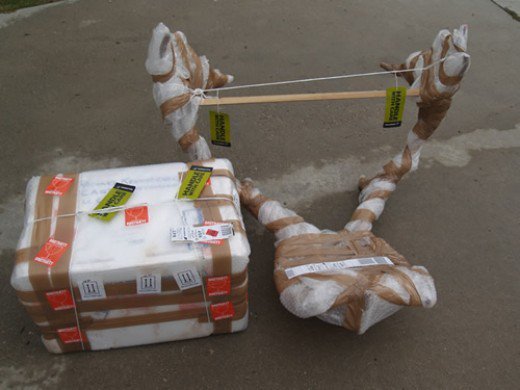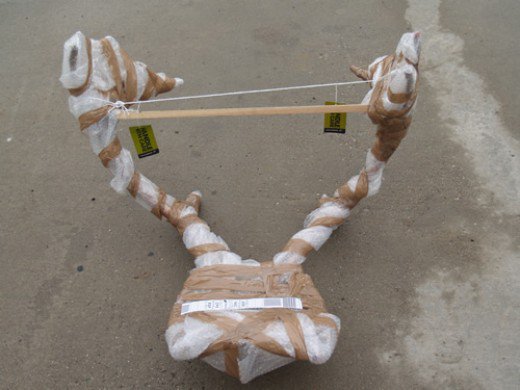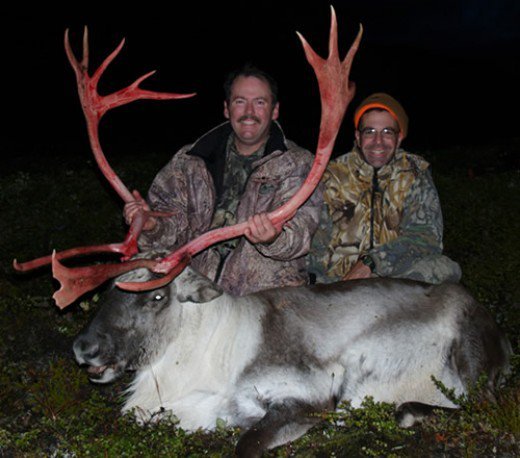
Trophy hunters who travel to their hunting destinations by airplane are always faced with the task of how to get their prized trophies back home safe and sound. The trophies at most risk of being damaged are antlered and horned game. With a little pre-prep work before you leave, you can make your trophy deer or elk rack strong enough to compete with all of the other Samsonite luggage and airline baggage handlers. While this article is mostly for hunters who travel internationally, this will also work for domestic airline travel too.
As in international trophy hunter, I have personally hunted and fished in 5 Continents. Airline travel is a necessary means of transportation to the majority of the destinations I have traveled to hunt. The ability to bring your trophy back as luggage can save you up to 6 months of time and up to $750 or more in import related expenses and shipping. Not all countries will allow this, but some do. The saving can almost pay for the taxidermy. I have brought back trophies as luggage from Canada, Mexico and Iceland. You must have all of your paperwork in order which I have covered in part in another article.
One big factor you must consider is the ability to keep the cape or rug frozen from the time you leave your hunting destination till the time you get home. In a lot of cases this requires a good 24 hours for a hard freeze. The cape or rug should be folded several times to save space and frozen solid. Hunters taking their trophies on the last day without time to freeze in camp may want to consider staying an extra day, especially if you are traveling from a foreign country back to the United States or have many layovers.
The U.S. Fish & Wildlife Service at Customs will check to make sure your cape or rug is frozen as they don’t want any blood to pass thru the luggage and the freezing also helps kill any unwanted bugs from coming into the United States. Place your wet cape or rug in a black trash bag twice and then freeze. Make sure you put a name tag on your cape. The tag should have your complete contact information on one side and your taxidermists contact information on the other. This way if your cape or rug gets separated from your luggage, the U.S. Fish & Wildlife will know how to contact you. Then put the frozen and bagged cape into a collapsible insulated cooler. In my last trip to Mexico, I brought back the cape of a Sonora Desert Mule Deer in a 10”x10”x9” collapsible insulated cooler with room to spare. Then I put the cooler in my Cabela’s Luggage. If you are bringing back an elk sized animal, you’ll need a bigger cooler.

When you get home, take your frozen cape right to your taxidermist. Leave it frozen as he or she may not have time to process it the moment you arrive. Remember, if you are coming in from Canada, Mexico or any other foreign country, you will need to designate a USDA Certified Taxidermist on your Form 3-177-1 and that is where you will need to take your frozen cape. This does not apply for domestic travel.
Protecting your Horn, Antlers and skullcap from breakage.
Your trophy animal’s horns or antlers are the most susceptible to breakage when traveling back with you on the airline. There are 3 steps to protect them when packaged as luggage. You will not need a box with this method. First, you will need to protect each tine or point. You can do this with pieces of a discarded garden hose cut into a variety of 3” to 6” lengths. You can use either a 5/8 or ¾ inch hose. Place the cut piece of hose over the point till it comes to a rest when the diameter of the horn is larger than the diameter of the hose. Make sure at least 1” to 1½” of hose extends beyond the tip and then duct tape the hose to the individual tine. Repeat this process until all tines of the antlers are protected.
Second, thoroughly wrap the skullcap with duct tape. Make sure your outfitter has boiled the skull cap and removed any fleshly and brain matter. This is a U.S. Fish & Wildlife Regulation.
Third, you will want to brace the inside span of the main beams. In the case of a mule deer or whitetail deer, one brace should be sufficient. In the case of a larger animal like an elk, you may want to use two braces. A good brace is a wooden dowel or a good straight stick. You will need to cut this brace to measure and place between the one or two of the thickest areas of the main beam, usually between C-2 & C-3 (see photo). Once you cut your brace to measure, duct tape it in place and then duct tape the brace as well. You don’t want the brace to be able to move. Don’t worry about the tape; your taxidermist will easily be able to remove any tape adhesive residue from the antlers. Once your tines are protected and the brace is in place, wrap the tines and main beams with bubble wrap and duct tape them in place. Be sure not to cover up any tags on the antlers and the U.S. Fish & Wildlife will need to see them. To some hunters this may seem a bit of an over-kill on the antlers. I know some who have gotten by with just the tines protected. International hunts are getting more and more expensive and the last thing I want to happen to my trophy of a lifetime is to get broken in transit. A lost tine or two during baggage handling will never be recovered and cannot be scored as such by Boone & Crocket, Safari Club International or Pope & Young. A little extra prep can insure your trophy arrives home in one piece.
At the Airline Check in Counter
When you are checking in your luggage, ask the attendant at the check in counter to tag your antlers with special handling. They will do this at no extra charge. You may incur extra baggage charges though. If you are a frequent flier with elite status, the extra baggage fees may be waived. Be sure and ask the attendant at the counter.
Going thru Customs & U.S. Fish & Wildlife
Any time you come back from a different country, you will have to collect your bags and go thru customs. Make sure you declare your entire trophy or it could be subject to seizure. Make sure you have all your paperwork in order. This includes your U.S. Fish & Wildlife Form 3-177-1 and the documentation from your outfitter. The outfitters documentation should include your foreign hunting license, game tag (should be placed on your antlers or horns before you leave the country) and any paperwork showing the outfitters license and the property where the hunt took place was legal to hunt.
Have all of these documents in your hand when you approach the U.S. Fish & Wildlife portion of U.S. Customs. The officer will surely appreciate this and it will make your transition run a whole lot smoother. After you pass thru Customs and U.S. Fish & Wildlife, you will recheck your bags to your final destination. If you are hunting domestically (within the United States), you will not need to go thru Customs or U.S. Fish & Wildlife.

Pre-trip packing list
You will want to take a few things in your luggage as you may not be able to find them or have time to buy them at your destination. Most of these items will fit in a large Cabela’s type duffle bag along with your hunting gear. You will need the following;
- A roll of bubble wrap. (get this at any office supply store like Staples or Office Max)
- A Roll of Duct tape (get this at any office supply store like Staples or Office Max)
- Pieces of garden hose cut to different lengths. Prepare for the largest deer or elk usually taken in the area. This way you
won’t come up short. Look in the garden shed for that old leaky hose you haven’t thrown away yet. - Wooden Dowel in ½” or 5/8” diameter. Again, prepare for the largest game usually taken in the area. Ask your outfitter
about rack spreads. Get one for Deer and 2 for Elk. Wooden Dowels can be purchased any home improvement store such as
Home Depot, Lowes or Menards, etc. - Collapsible Insulated Cooler. You can find these at Wal-Mart for $10-$15.
- Taxidermy Tags. Ask your Hunting Consultant or make your own. I recommend laminating the tags. You should have one
for the antlers, one for the cape and one for the insulated cooler. - Plastic Zip Ties to attach the Taxidermy tags.
- 2 Heavy Mil Trash bags to wrap your cape or rug.
If you ask, your outfitter may be willing to pick up these items before you arrive in camp which will save you some space in your luggage. If you are traveling to a domestic hunting destination, you can purchase these items and have them shipped to your outfitter. I would not recommend shipping if you are going to Canada, Mexico or any other international destination as it would be too costly for shipping, customs, etc. and they package may not make it to the outfitter in time. Ask your outfitter for a UPS address and send it well ahead of time. Make sure there will be someone to accept the package. During the hunting season, many outfitters are in the field.
With a little bit of pre-planning, you will be able to bring home your next deer or elk trophy as luggage and not have to worry about it being broken by baggage handlers or other heavy luggage. You can use the money you saved to apply to the taxidermy bill.
Congratulations @wyomingrick! You have completed some achievement on Steemit and have been rewarded with new badge(s) :
Click on any badge to view your own Board of Honor on SteemitBoard.
For more information about SteemitBoard, click here
If you no longer want to receive notifications, reply to this comment with the word
STOPHi! I am a robot. I just upvoted you! I found similar content that readers might be interested in:
https://skyaboveus.com/hunting-shooting/deer-or-elk-trophy-as-airline-baggage